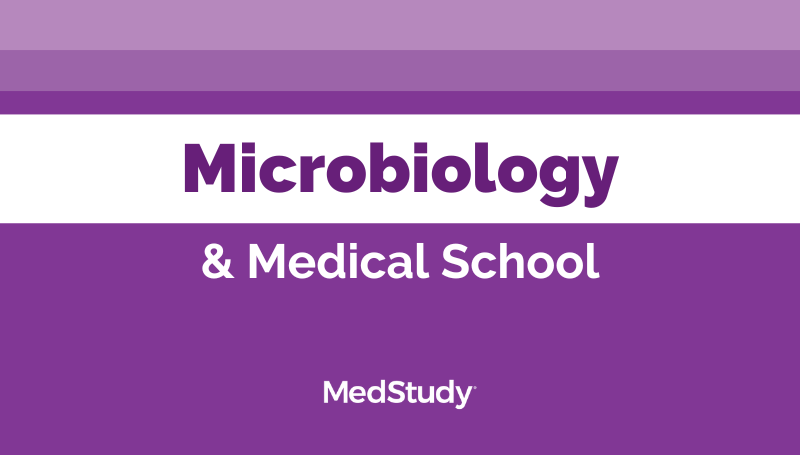
Key Takeaways:
- Microbiology is challenging but foundational, as it impacts various medical disciplines.
- Microbiology knowledge is crucial to cover all of the the topics outlined in the USMLE® Step 1 content.
- How to study for microbiology: find the right resources, get a comprehensive foundation, use patient cases to review, and break up learning into manageable chunks.
- Utilize a dedicated microbiology textbook and organize information through “chunking” to enhance learning.
- Use practice quizzes and exams, like Qbank+, to reinforce microbiology concepts and boost confidence.
Let’s be honest, studying microbiology can seem pretty daunting. With a multitude of microorganisms to classify, an array of toxins and enzymes to remember, and a seemingly endless list of bacteria, viruses, fungi, and parasites with perplexingly similar names, it’s no wonder that many medical students find themselves overwhelmed.
If you’ve ever grappled with these concerns, you’re not alone. In this blog, we’re diving headfirst into how to study microbiology, unraveling its complexities, and shedding light on the importance of understanding this subject.
What do you learn in microbiology?
Microbiology encompasses a range of topics, including bacteria, viruses, fungi, parasites, and prions. To give you a sense of the scope, let’s look at the USMLE® outline for Microbial Biology:
- Microbial biology
- Microbial identification and classification, including principles, microorganism identification, and non-immunologic laboratory diagnosis
- Bacteria
- structure (eg, cell walls, composition, appendages, virulence factors, extracellular products, toxins, mechanism of action of toxins)
- processes, replication, and genetics (eg, metabolism, growth, and regulation)
- oncogenesis
- antibacterial agents (eg, mechanisms of action on organism, toxicity to humans, and mechanisms of resistance)
- Viruses
- structure (eg, physical and chemical properties, virulence factors)
- processes, replication, and genetics (eg, life cycles, location of virus in latent infection) oncogenesis
- antiviral agents (eg, mechanisms of action on virus, toxicity to humans, and mechanisms of resistance)
- Fungi
- structure (eg, cell wall, composition, appendages, virulence factors, extracellular products, toxins, mechanisms of action of toxins)
- processes, replication, and genetics (eg, asexual vs. sexual, metabolism, growth)
- antifungal agents (eg, mechanisms of action on fungus, toxicity to humans, and mechanisms of resistance)
- Parasites
- structure (eg, appendages, macroscopic features, and virulence factors)
- processes, replication, and genetics (eg, life cycles, metabolism, and growth)
- oncogenesis
- antiparasitic agents (eg, mechanisms of action on parasite, toxicity to humans, and mechanisms of resistance)
- Prions
What is microbiology the study of?
Microbiology is the study of microorganisms, which are tiny, often microscopic life forms that exist all around us. Microbiology delves into the world of these tiny creatures, exploring their structure, genetics, physiology, and their interactions with other living organisms and the environment.
In addition to studying the individual microorganisms themselves, microbiology also examines how they interact with their hosts, how they can be identified and classified, how they cause diseases, how to diagnose infections, treatment options, and strategies for preventing the spread of infectious agents. Our Microbiology Core books keeps it high level, and then you can dive more into the other topics in the Infectious Disease section.
For medical students, microbiology is about understanding the roles of different microorganisms in the context of medicine for your future patients. Whether it’s diagnosing a bacterial infection or virus, without a solid foundation of microbiology, you might not have the knowledge to properly diagnose your patients.
Is microbiology a hard class?
Microbiology is often considered one of the toughest subjects in medical school. Reddit r/medicalschool threads and Student Doctor Network (SDN) threads are filled with discussions on the topic. The reasons for its difficulty are clear: the extensive content, the need to apply it clinically, and the fact that missing crucial concepts can hinder your understanding of other medical disciplines down the line.
The sheer amount of information can be overwhelming. For example, for each microorganism, students need to learn about its structure, pathogenesis, clinical manifestations, diagnostics, treatments, and prevention.
Medical students need to be able to apply their basic science knowledge of microbiology to clinical scenarios. Understanding how a microorganism’s biology translates into clinical symptoms, diagnostic tests, and treatment strategies are essential.
Why is microbiology important?
Despite its reputation as a challenging subject, microbiology is undeniably important. It plays a critical role in medicine and healthcare, as demonstrated by the USMLE® Step 1 content outline, which assigns a significant weight to microbial biology, 10-15% to be exact. Understanding microbiology is essential for diagnosing and treating diseases.
Plus, microbiology knowledge is foundational for other medical school subjects. For example, when you get to pharmacology, you’ll use microbiology knowledge when selecting appropriate treatments, and in pathology you’ll use it to understand the tissue response to infections.
How to study for microbiology in med school
Effective microbiology study involves using the right resources, getting a comprehensive foundation, using patient cases to review, and breaking up learning into manageable chunks. Let's take a look:
Find the right resources
For this part, the Microbiology Medical Student Core book is going to be your best friend. Unlike a lot of the other microbiology tomes written for microbiologists or students interested in biotechnology who need way more detail than you need for your medical practice, the microbiology Core book breaks down only what you need to know for the USMLE® exams.
In 37 pages, the microbiology Core book covers the basics of what you need to know in manageable chunks. Within the content there’s 33 images, illustrations, and charts that make the content more digestible. Microbiology content is also referenced throughout other books in the Core for a more comprehensive review.
Use this microbiology textbook as a study aid
To succeed in microbiology, it’s crucial to have a dedicated microbiology textbook as your study companion. Consider using a resource like the Medical Student Core Microbiology book, which provides comprehensive coverage of the subject. An effective study technique is “chunking” information—grouping related concepts together to make them easier to learn and remember. For example, organize microbiology topics by category and subcategory.
Check it out for yourself!
Get a comprehensive overview of microbiology
Because there is so much to memorize in Microbiology, it requires a strategic study approach. Begin by understanding the fundamental concepts. Know the basic structure, reproduction, and general mechanisms of pathogenicity for each category. Try to get the basics down pat before moving on. This foundational knowledge will serve as your anchor as you delve deeper into the subject.
This microbiology textbook “chunks” up the information by topic, and then by subtopic, to make it easier for you to learn and memorize. For example, the Parasites section begins with an overview, then splits parasites into protozoa and helminths. Helminths are split into cestodes, trematodes, and nematodes. Then we go into the oncogenesis and antiparasitic agents for parasites.
Use patient cases to study
Why did you choose to study medicine? Most students would probably say to help people. The best way to keep your mind focused on your why is to imagine yourself in your role as a physician helping patients. And, the best way to do that is by answering Qbank+ questions.
Try it out with this Step 1 Qbank+ question. Imagine yourself in the exam room with this 19-year-old woman, how would you answer?
We provided the full answer and explanation at the end of this blog
And, in the Medical Student Core, there are Clinical Pearls pulled out from the content and highlighted for you, so you can imagine yourself in patient scenarios like the one below. Clinical Pearls offer a unique way to visualize why what you’re learning in microbiology will be important to your future patients!
Clinical Pearl from the Microbiology Medical Student Core book
Review in manageable chunks
The microbiology Core book breaks down what you need to know in 37 pages, and then the Step 1 Qbank+ has 20 questions to help you cement in the concepts and help you focus on what you need to know for your exams and clinical practice.
You can further simplify the material and break it down into manageable chunks with Personal Trainer. When you set up your Personal Trainer, pull the microbiology section to the top to start studying right away. Then, each day, it will give you questions to review and sections to read in the microbiology Core content to get all of the information down by your desired study goal time.
Microbiology help for students
Studying microbiology can be challenging, but you don’t have to go it alone. Resources like the Microbiology Medical Student Core book and Qbank+ can be super valuable aids in your journey. Use these tools to reinforce your learning through reading and practice quizzes.
As you embark on your microbiology study journey, remember that it’s not just about acing exams—it’s about acquiring the knowledge that will enable you to make a difference in your patients' lives down the line.
Approach microbiology with a strategic study plan and unwavering motivation, your dedication to mastering microbiology will pay off as you become a skilled and knowledgeable physician! You’ve got this!
Here's the answer to the Step 1 Qbank+ question above! Use the arrows to click through to the full explanation.






